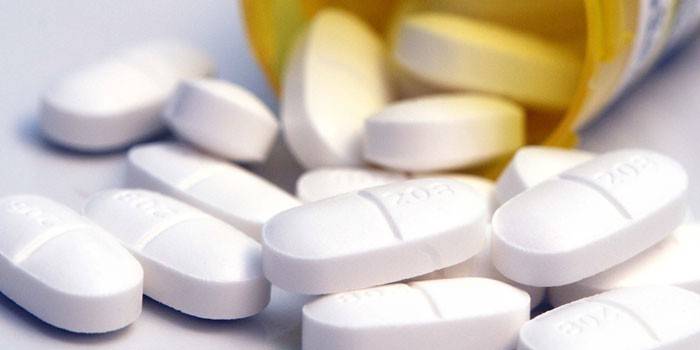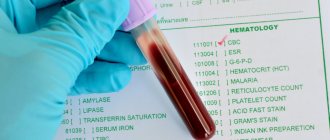Complexes with this research
Advanced female anti-aging diagnostics Advanced monitoring of basic blood parameters in a woman aged 40+ 28,680 R Composition
Advanced male anti-aging diagnostics Advanced monitoring of basic blood parameters in a man aged 40+ 33,710 R Composition
Monitoring of diabetes mellitus Monitoring of the condition of patients with diabetes mellitus (every 6 months) 1,900 RUR Composition
IN OTHER COMPLEXES
- Women's anti-aging diagnostics RUB 12,070
- Anti-aging diagnostics in postmenopause RUB 12,630
- Women's check-up No. 1 RUB 19,290
- Vegetarians and vegans RUB 5,820
- For those at risk of COVID-19 RUB 4,510
Albumen
(information for specialists)
Albumin is the main protein fraction of blood. It accounts for about 60% of the total amount of plasma proteins. It is a significant component of the intercellular fluid; slightly more than half of the total amount of albumin is located in the extravascular space (intercellular fluid, lymph). Present in cerebrospinal and amniotic fluid. Albumin is synthesized in liver cells from amino acids. Synthesis depends on the amount of proteins supplied with food and the osmotic pressure of the blood. The half-life of the albumin molecule is about 20 days. It is filtered in small quantities in the renal glomeruli, then reabsorbed in the tubules back into the blood, thereby entering the urine in minimal quantities (the norm is up to 20 mg/l).
Albumin performs important functions in the body.
Let's consider the transport function. It involves binding and transporting vitamins, calcium, drugs, toxins, bilirubin, and fatty acids. The transfer is carried out due to the content of hydrophilic and lipophilic bonds on the albumin surface. The albumin molecule binds most strongly to non-esterified (free) fatty acids, transporting them to the liver. This is the essence of the antitoxic barrier of albumin against fatty acids. As a result of the formation of the complex albumin, an inactive form of calcium, a relatively constant concentration of calcium ions in the blood serum is maintained. The albumin molecule firmly binds insoluble bilirubin, delivering it to the liver for further excretion as part of bile. The effectiveness of drugs is largely determined by their ability to compete for binding to albumin. Metabolites of a malignant tumor are able to bind to the molecule of this protein. Therefore, albumins can act as markers of a pathological process.
Blood plasma is a complex colloidal solution in which negatively charged small particles are distributed. The more of these small particles with a negative charge, the greater the force of repulsion between them, which determines the stability of the colloidal solution. The colloidal stability of plasma is mainly determined by albumins, because Compared to other plasma proteins, albumin molecules are smaller and their concentration is higher. Due to their properties, albumins are able to maintain oncotic pressure, i.e. capable of binding water in a colloidal plasma solution. If the level of albumin decreases (hypoalbuminemia), and therefore oncotic pressure, this leads to the transition of water from the vascular bed into the intercellular space. Intercellular (interstitial) tissue edema develops.
Albumin also performs a nutritional function, i.e. serve as a reserve of amino acids. This function is activated during fasting.
In acute or chronic liver failure, albumin synthesis is severely impaired, which leads to hypoalbuminemia. Since all blood plasma proteins are synthesized in the liver (with the exception of immunoglobulins), in diseases leading to liver failure, a violation of the protein-synthetic function of the liver occurs. This function is reduced when more than 50% of functioning hepatocytes are lost.
A decrease in blood albumin, as well as total protein, may indicate increased catabolism. This condition is confirmed by changes in the level of urea in the blood (an indicator of the final breakdown of protein). Increased catabolism is characteristic of thyrotoxicosis, infectious and rheumatic diseases, and febrile conditions. In inflammatory diseases, protein loss may occur into the extracellular space with the formation of exudate.
A physiological decrease in blood albumin is observed during pregnancy and with insufficient protein intake from food. When taking oral contraceptives, hypoalbuminemia is caused by the action of estrogens. In people who smoke, there is a slight decrease in albumin levels compared to non-smokers. In children, the normal values of this indicator are slightly lower than in adults.
There is no increase in the absolute amount of albumin. A relative increase in level is possible as a result of hemoconcentration during dehydration.
Indications for use
1) Liver diseases;
2) Kidney diseases with large protein loss and edema;
3) Diseases of the gastrointestinal tract, accompanied by impaired protein absorption;
4) Extensive burns leading to large fluid loss;
5) Oncological diseases;
6) Before planned surgery;
7) Acute and chronic inflammatory diseases.
Preparing for analysis
1) Blood from a vein is donated in the morning, on an empty stomach (the last meal was at least 8 hours ago). You can drink the water;
2) A few days before the test, avoid intense physical activity, prolonged standing, limit the intake of fatty meat foods and alcohol;
3) Taking high doses of prednisolone and using estrogen-containing contraceptives may distort the results obtained;
4) Prolonged tugging with a tourniquet may slightly overestimate the true result.
Reference values
1) Children under 3 years old – 25-55 g/l;
2) Adults up to 60 years old – 38 – 50 g/l;
3) Over 60 years old – 34 – 48 g/l.
Interpretation of results
| Level reduction | Level up |
| Hepatitis (viral, drug-induced, toxic) | Dehydration with prolonged vomiting and diarrhea |
| Alcoholic liver disease | Taking vitamin A (retinol) |
| Liver injuries | |
| Liver tumors (including metastatic) | |
| Cirrhosis of the liver | |
| Liver failure | |
| Parasitic liver diseases (echinococcosis) | |
| Nephrotic syndrome | |
| Bleeding | |
| Acute and chronic infectious diseases | |
| Exudate formation | |
| Burn disease | |
| Radiation sickness | |
| Rheumatic diseases | |
| Nutritional protein deficiency | |
| Enteropathies with protein malabsorption | |
| Taking estrogens, glucocorticosteroids (high doses) | |
| Pregnancy |
Detailed description of the study
Albumin is a blood plasma protein that, by mass, occupies more than half of all plasma proteins. It performs a number of important physiological functions:
- Maintaining physical and chemical blood parameters: viscosity, pH, oncotic pressure;
- Regulation of circulating blood volume and its balance with intercellular fluid;
- Transport of certain hormones, drugs, fats and their complexes;
- Calcium binding and participation in its metabolism;
- Protein reserve: if there is not enough protein in food, albumin can become its source.
Albumin is synthesized in the liver under the influence of thyroid hormones and growth factors, and is excreted by the kidneys. If too little of it is produced in the liver or if it is excessively excreted in the urine, its plasma concentration decreases. This condition is called hypoalbuminemia.
The causes of low albumin levels can be acute and chronic liver diseases, which affects its synthetic function, kidney pathologies, and insufficient protein intake from food. Hypoalbuminemia can be a manifestation of hormonal diseases, intestinal pathologies and cancer. Regardless of the cause, a decrease in plasma albumin levels manifests itself externally as edema.
Physiologically, this is reflected in the properties of blood and transport functions. For example, the content of free molecules of drugs taken in the blood will increase. This may increase their side effects.
Increases in plasma albumin levels are rare: with dehydration or recent intravenous protein administration.
Albumen
Albumi n
- the main protein of blood plasma. Research method: colorimetry with bromocresol green. Albumin synthesis occurs in the liver. The relative molecular weight of albumin is 65,000 Da. The half-life is 18–20 days. Albumin maintains the colloid-osmotic (oncotic) pressure of plasma, and, accordingly, the volume of circulating blood. It is a reserve of protein - during prolonged fasting it is consumed first. Albumin performs a transport function by binding to bilirubin, bile acids, metal ions, in particular calcium, free fatty acids and drugs entering the body from the outside, such as antibiotics and salicylates.
Albumin levels are slightly lower in young children, in women during pregnancy, especially in the third trimester, and during lactation, as well as in smokers.
Hypoalbuminemia causes a decrease in total plasma calcium, the shift occurs due to the physiologically inactive part of calcium associated with albumin, and clinically calcium deficiency does not manifest itself. The effects of drugs that bind to albumin, such as corticosteroids, are enhanced by hypoalbuminemia. As a result, toxic effects may develop at normal dosages of drugs.
Indications:
- liver and kidney diseases;
- burns;
- oncological diseases;
- malabsorption syndrome;
- rheumatic diseases.
Preparation
It is recommended to donate blood in the morning, between 8 am and 12 pm. Blood is drawn on an empty stomach, after 6–8 hours of fasting. It is allowed to drink water without gas and sugar. On the eve of the examination, food overload should be avoided. It is necessary to take into account that prolonged clamping of blood vessels during blood collection and “hand work” can slightly increase the concentration of protein in the serum.
Interpretation of results
Units of measurement: g/l.
Increased albumin levels:
- dehydration;
- hemoconcentration.
Decreased albumin levels (hypoalbuminemia): Decreased albumin synthesis in the liver:
- chronic liver diseases (hepatitis, cirrhosis, atrophy, carcinoma).
Insufficient dietary intake:
- fasting, cachexia, low-protein or unbalanced diet in amino acid composition;
- malabsorption syndrome (gastroenteropathy) and gastrointestinal pathology.
Increased protein loss:
- chronic renal pathology (nephrotic syndrome, diabetic nephropathy);
- thermal burns;
- tissue injuries;
- after bleeding and administration of blood substitutes;
- formation of exudates and transudates.
Increased catabolism:
- feverish conditions;
- sepsis, infectious diseases;
- thyrotoxicosis;
- malignant neoplasms;
- rheumatic diseases;
- overhydration (increase in circulating blood volume);
- genetic defect - analbuminemia;
- congestive heart failure;
- taking medications such as estrogens, oral contraceptives, amiodarone, steroid hormones (in high doses).
Albumin medicine
The drug is obtained from the blood plasma of humans and animals. The drug Albumin has gained popularity in serum form. A protein solution demonstrates great effectiveness in treating low blood pressure and eliminating various critical conditions - it is administered using a dropper. The rate of delivery of the medicine is determined by the condition and age of the patient. The drug in powder form is easily soluble in water. The medicine cannot be combined with other protein-based medications.
Albumin solution
The substance is a light brown or yellowish liquid. Albumin solution is obtained from human blood plasma, dividing it into fractions. The drug quickly increases blood pressure, restores blood circulation and plasma pressure. After administration of the solution, the amount of tissue fluid in the bloodstream increases, which leads to better absorption of drugs. The drug is administered intravenously every 10-12 hours.
Albumin tablets
This form of the drug has reduced effectiveness. Albumin tablets are used to treat anemia, anemia and as a means of stabilizing blood pressure in elderly patients. The reduced effectiveness of the tablets is due to the membrane resistance of red blood cells. Solid dosage medications are broken down by the duodenum by 50 percent. One tablet contains excipients to accelerate the absorption of the element.

- What does paracetamol help with: the effect of the drug
- Hemostatic drugs for heavy periods
- Homemade acne mask - effective recipes. Homemade masks for acne on the face







